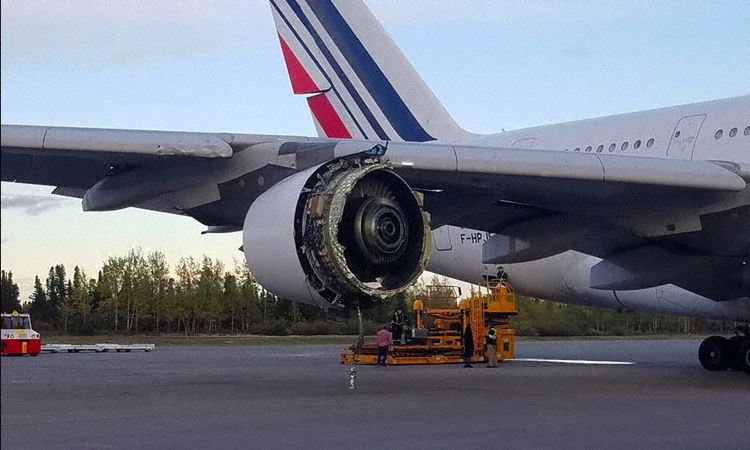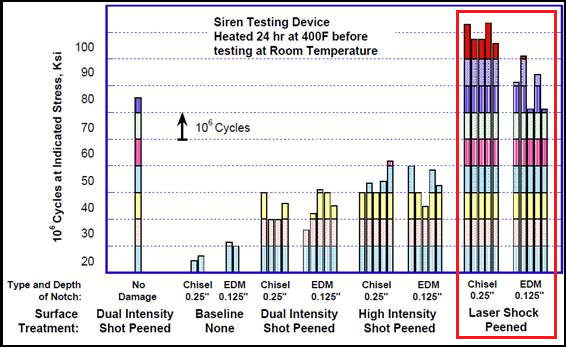Engine Explodes During Overseas Flight with 520 on Board
Laser shock peening (LSP) was invented to prevent fatigue failures in aircraft engine components. The process imparts deep compressive residual stresses for enhanced fatigue resistance and crack inhibition.
Posted: October 4, 2017
By:

“Uncontained engine failure” forces emergency landing of Airbus A380 – the world’s largest passenger aircraft.
A large turbofan engine exploded during an Air France flight over the weekend. The incident occurred Saturday, September 30th as an Airbus A380 flying from Paris to Los Angeles cruised over Greenland at 38,000 feet. Passengers described a loud bang, followed by a brief lurching of the aircraft and several minutes of intense vibration. The hobbled aircraft flew for about an hour before making an emergency landing at Goose Bay Airport in eastern Canada.
“It was like the plane hit a Jeep at 35,000 feet,” explained passenger Pamela Adams in an interview with the Associated Press. Another passenger, John Birkhead told the New York Times, “We were just stretching and talking, and suddenly there was an enormous bang and the whole plane shook.”
The below video from NBC News shows the aircraft landing at Goose Bay with one severely disabled engine.
Big plane at a small airport
The Airbus A380 is the world’s largest passenger aircraft, and the Air France flight was near capacity with 496 passengers and 24 crewmembers on board. With the plane traversing the northern Atlantic at the time of the incident, the pilots had limited options for emergency landing sites.
The crew ultimately diverted to a small airport in the Canadian province of Newfoundland and Labrador, and executed a successful landing to the relief of everyone on board. “Just glad to be on the ground,” one passenger tweeted. The tiny Goose Bay Airport was ill-equipped to accommodate a Super Jumbo airliner, and 500 passengers stayed aboard the plane for hours while the airline dispatched additional aircraft to retrieve them.
Uncontained engine failure

Images of the damaged engine show the tattered remains of a violent failure. The entire cowling, or engine covering, appears to be sheared off and there is damage to the aircraft wing. The first-stage fan is missing – completely separated from what appears to be a fractured disk and exposed turbine shaft. This has led to speculation that the fan disk ruptured and the fan separated from the engine, ripping apart the surrounding cowling in the process.
Uncontained failures are among the most dangerous aircraft engine malfunctions. Fractured components like fan or compressor blades can be ejected from the engine housing at high velocity – posing serious risk to passengers and other aircraft systems. Liberated engine fragments can sever fuel or hydraulic lines, damage critical aircraft controls, or even penetrate the fuselage and passenger cabin.
The failed engine was a GP7200, a high-bypass turbofan manufactured by Connecticut-based Engine Alliance. The company is a joint venture of engine makers General Electric and Pratt & Whitney, and primarily manufactures the GP7200 for the Airbus A380. It is one of the largest and most powerful engines ever produced, with a fan spanning almost ten feet in diameter.
What might have caused the engine failure?
Explosive engine failures are rare, particularly on such large commercial aircraft. This is the second uncontained failure in ten years of A380 operation, and the first for the GP7200 engine. German news agency Deutsche Welle spoke with aviation expert Heinrich Großbongardt, an industry consultant who’s spent 25 years advising aerospace companies. Mr. Großbongardt explained that, “The most likely scenario is the so-called ‘fan disc’ – a massive piece of metal – developed some sort of crack, which led to the disintegration of the entire disc and the loss of all fan blades.”
“In general,” Mr. Großbongardt explained, “the cause of such a crack is fatigue… probably there was a fault in the material which remained undetected, or there was an initial crack which was undetected in the maintenance work.”
Aircraft engine blades and discs are subject to tremendous forces. These components endure the tensile stress of cyclic loads that repeat for millions of cycles. If indeed a material flaw or crack evaded detection, that crack would grow until it undermined the component’s ability to withstand operating forces. Fatigue failures in this mode happen quickly and unexpectedly, highlighting the importance of metal fatigue enhancement to impede crack initiation and growth.
Preventing explosive engine failures
Laser shock peening (LSP) was invented to prevent fatigue failures in aircraft engine components. The process imparts deep compressive residual stresses for enhanced fatigue resistance and crack inhibition. Laser peening is so effective because it enhances the material deep beneath the part surface, slowing the spread of fatigue cracks that might otherwise go undetected.
In the mid-1990s, laser peening spurred a revolution in engine safety when the process was applied to titanium fan blades for the GE F101 engine. The application significantly impeded cracking associated with foreign object damage (FOD), and protected the F101 engine from unexpected fatigue failures. Laser peening proved to be so powerful at extending fatigue life that even damaged blades treated with LSP lasted longer than undamaged blades with no laser peening treatment.

Since that initial landmark investigation, aerospace OEMs have increasingly turned to laser peening to extend the fatigue life of critical components. Engine maker Rolls Royce – manufacturer of the Trent 900 engine that suffered an uncontained failure during a Qantas A380 flight in 2010 – now applies laser peening to first stage fan discs, blades, and dovetail slots following that high-profile incident. Laser peening has also been applied to bulkheads, landing gear, wing lugs, arresting hooks, and other critical aerospace components to avoid catastrophic fatigue failures.
This Air France engine explosion is a sobering reminder of how suddenly and catastrophically metal fatigue failure can strike. It’s a testament to aerospace engineering and pilot training that the aircraft landed safely with no injuries reported among the 520 people on board. LSP Technologies is proud to play a leading role in advancing aerospace safety and preventing dangerous metal fatigue failures.
Prevent Metal Failures With Laser Peening
Interested in Seeing More?
Tell us about your application, material, or failure mechanism and we will have one of our experts reach out to you. Our extensive library of research and years of experience gives us a unique advantage to apply a finite element analysis to help diagnose the best application for your situation.
